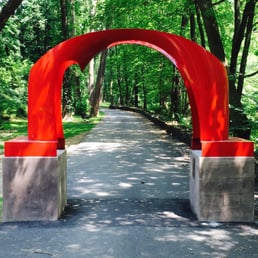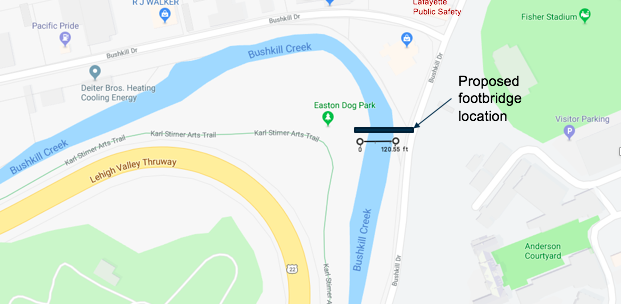“In what ways would a new artistic footbridge at the Karl Stirner Arts Trail enhance Easton’s community?”

The Karl Stirner Arts Trail (KSAT), running 1.75 miles along the Bushkill Creek in Easton, PA, is a trail designed to be a quiet recreational space for members of the community. Named after Karl Stirner, a World War II Veteran who was a key player in the revitalization of Downtown Easton’s art culture, the trail is also a space to showcase various pieces of art, mainly in the form of sculpture. Currently, the main one mile stretch along the Bushkill Creek, which showcases most of the art, has only two access points at either end. The KSAT Board has envisioned another access point- a bridge at the corner of Bushkill Dr and Detrich Rd (see Figure 1) , serving as a gateway to the Lafayette College campus and the College Hill neighborhood.

FIgure 1: Proposed Footbridge location on map.
As a real asset to the community, we believe that the Arts Trail could be utilized and recognized more than it currently is, and we believe that an additional footbridge would help to do this. At its proposed location , this footbridge has the potential to better connect various Easton neighborhoods, foster a better relationship between Easton and Lafayette College, and improve the social capital and economic growth of the city. Currently, growth is already occurring in this area in the form of new sculpture additions, a winding mulch path branching off of the KSAT toward the river dubbed the “KSAT Nature Trail”, the nearby redeveloping Simon Silk Mill, and the upcoming installation of an interactive “Musical Playground”, as studied in and made possible in part by a previous capstone report studying the feasibility of a KSAT Musical Playground (found here), completed during the Fall of 2015. This recreation space is being shaped for an appealing, beautiful, interconnected one- the only thing missing being an accessible entryway to the KSAT for about 10,000 of Easton’s residents that reside in the College Hill neighborhood (College Hill, 2015), and an additional 2,500 students at Lafayette College during about ¾ of the year.
This report serves as a feasibility study for this vision; in other words- an analysis of the benefits and possible drawbacks of constructing such a bridge, as well as how this project fits into the larger narrative of downtown Easton and the Karl Stirner Arts Trail. Undertaken by four senior capstone students from the Engineering Studies department at Lafayette College, this study takes a comprehensive look at the Social, Political, Economic, and Technical contexts surrounding the project. It is designed to serve as the first of potentially many iterations of this project, which will eventually deepen in complexity and technicality. At this stage, our goal was to take a big picture approach and lay the groundwork for future project teams.
The following is a brief overview of each section, which you can read more about on their respective pages.
Social
The Social Context section of this report focuses on the non-technical benefits that could be realized by implementing the footbridge. Special attention is given to how an additional footbridge at the Karl Stirner Arts trail could positively influence the Recreation and Public Health of Easton, its prevalent art culture, and the relationships within the community. By functioning as an additional KSAT art piece and as part of a new gateway between Easton and College Hill, this bridge has the potential to foster a more positive and productive relationship between Lafayette and Easton, increase the recreational possibilities in Easton, and contribute to Easton’s thriving art culture. Another focus in this section is the importance of usability, safety, and connectivity in public recreation spaces, and how that can positively influence the physical, mental, and emotional health of community members.
Additionally, in this section, we touch on Environmental concerns. This differs from the previous parts of this section as it describes more cautionary considerations regarding the environment rather than direct benefits. Things to be aware of, which are elaborated on at the end of the Social Context, are the delicacy of the Bushkill Creek environment and how adding a new footbridge might disrupt this, directly via the construction and physical existence of this bridge, or through increased human usage in this area.
Political
Our analysis of political context surrounding this footbridge chiefly involved personal contact with those who played a role in the project’s inception as well those who have insight into the process of engineering projects such as this. Jim Toia, The Chair of Karl Stirner Arts Trail Board of Governance and Dave Hopkins, the Director of Public Works for the City of Easton, were the most valuable of our contacts- both of who we were able to speak to in person. Toia provided insight into how the decision to design this bridge agreed upon and what purposes this bridge was intended to serve. Hopkins, currently doing work on a similar footbridge to be constructed adjacent to the Simon Silk Mill, was able to provide very valuable insight to the process that must be undertaken to successfully implement an engineering project such as this footbridge that we want to see become a reality. The principal challenges that face this footbridge is funding and its long permitting process. In our “Political Context” section, these concerns are explored in more detail, such as who needs to be appealed to for the purpose of acquiring such funding.
Technical
The technical context offers a brief overview of the space in which the bridge would be located, the potential design considerations for the bridge including inspirations from other places, a summary of materials that this bridge could be made up of, and special handicap considerations outlined by the Americans with Disabilities Act and the United States Access Board.
The purpose of this bridge goes beyond utilitarian. As an additional art form and a connection between the communities of Lafayette and Easton, the bridge needs to be designed in a way to make the bridge impart a certain experience and make people want to walk on the bridge. Creative use of materials (the ones analyzed in this report are Stone, glass reinforced plastic, and weathering steel) and art forms could help garner community interest for the bridge. Lastly, this bridge should be accessible to everyone in the community, including the handicap, which comes with a set of specific design requirements to ensure that individuals who struggle with mobility can maneuver the bridge and use the KSAT.
Economic
To understand the overall context surrounding this project, an economic analysis is important. This analysis can be used to highlight a core purpose of this report– to assess the potential value of the proposed footbridge. Ideally, the economic context will shape the ways in which the bridge can add to the trail, which is an asset for the Easton community. To do this, benefit/cost analysis is used so that subsequent steps, such as funding, construction, and maintenance, can be completed effectively.
While this project will accrue various costs, this section is intended to highlight the ways in which the bridge will enhance the overall social connectivity within Easton and its surrounding communities. This is relevant to the economic analysis because as community members utilize the trail and visit the area, social capital will increase. Essentially, this is the idea that walkability will ultimately lead to economic benefits because of the direct relationship people have with economic entities. This section seeks to emphasize how this affects the overall value of the bridge and the ways in which long term benefits can be created through enhanced social capital.
Challenges
The installation of this footbridge comes with a number of unique challenges, limitations, and obstacles. On the more logistical and technical side, issues of funding, location, and design need to be addressed. This project would come with considerable costs to design, build, and install, requiring multiple funding sources, or one of a large sum. Given the nature of city funded projects as ones focused more on utility and necessity, the source would likely need to be by grant or private Lafayette alumni donors. It may come to be that the limitations in funding in turn determine how this bridge could be designed, as more elaborate designs are likely to involve more material, design time, and therefore higher costs. We discuss these issues of funding more in the Political and Economic sections.
Currently, the proposed location was determined by the KSAT Board and given to us to analyze. While this is the corner that the bridge would be placed for its easy access from College Hill, the exact location within this corner is determined in part by the existence of the IAS Car Dealership . This limits the possibility that the corner could turn into a true gateway for Lafayette and the College Hill area, however, the social and economic benefits realized by the bridge are not altered significantly by this fact.
On the more social side of things, any project like this faces the possibility of community opposition. As we elaborate on in the Social Context, we are currently in a moment of tension between the College Hill Neighborhood and Lafayette College, as Lafayette intends to expand into College Hill territory. Given that this bridge is intended to bring those communities together and intermingle them further, it is bound to be the subject of some criticism.
To navigate through the context pages of this report, use the links below or the tabs on the top of the page.
